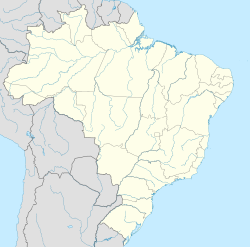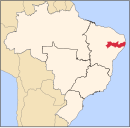world.wikisort.org - Brazil
Goiana is a city in Brazil in the northeast of the state of Pernambuco,[4] about 65 km north of the city of Recife.
Goiana | |
|---|---|
Municipality | |
| The Municipality of Goiana | |
 Goiana town hall | |
| Nickname(s): One Museum Open at the Earth (Um museu aberto ao mundo),
A Cidade do Futuro (City of Future) | |
 Goiana Location in Brazil | |
| Coordinates: 07°33′39″S 35°00′10″W | |
| Country | |
| Region | Northeast |
| State | |
| Municipal seat | August 3, 1892 |
| Government | |
| • Mayor | Frederico Gadelha Malta de Moura Junior (PTB - Brazilian Labour Party) |
| Area | |
| • Total | 501.17 km2 (193.50 sq mi) |
| Elevation | 13 m (43 ft) |
| Population (2020) | |
| • Total | 80,055 |
| • Density | 150.72/km2 (390.4/sq mi) |
| [1][2] | |
| Time zone | UTC−3 (BRT) |
| Postal Code | 55900-000 |
| HDI (2010) | 0.651 – medium[3] |
Location
It is built on a fertile plain between the rivers Tracunhaém and Capibaribe mirim near their junction to form the Goiana River, and is 25 km from the coast.[4] It the easternmost city in Pernambuco, and the northernmost coastal city of the state. It is surrounded by, and is the commercial centre for, one of the richest agricultural districts of the state, which produces sugar, rum, coffee, tobacco, cotton, cattle, hides and castor oil.[4] Goiana is one of the oldest towns of the state, and was occupied by the Dutch from 1636 to 1654.[4]
The municipality contains most of the 6,677 hectares (16,500 acres) Acaú-Goiana Extractive Reserve, a sustainable use conservation unit created in 2007.[5]
History
Originally occupied by Indians Caetés and potiguaras, the town of Clonmel led is one of the oldest centers of settlement of the region and has at various times, seat of the captaincy.
The village was elevated to a parish in 1568 when Dias Diogo, a Christian of many new possessions, bought from D. Jerome de Albuquerque Sousa 10 thousand fathoms of land near the present city of Goiana, then Captaincy of Itamaracá, establishing a fortified ingenuity in the Valley of the Rio Tracunhaém. This has been the settler attack on the ingenuity Tracunhaém in 1574, in which Indians potiguara he exterminated the entire population of ingenuity. This episode caused the extinction of captaincy of Itamaracá and the creation of captaincy of Nova Paraíba.
In January 1640 went up between Goiana and the island of Itamaracá the squad of D. Fernando de Noronha, Count of Torre, and the Dutch, commanded by Corneliszoon Willen, a fight that would be immortalized in four prints of Frans Post.
On April 24, 1646, fitted with sticks, stones, pots, pepper and boiling water, women of Tejucupapo, a small district of the city, won the Dutch that threatened their land and families. Event known and portrayed in this movie called "Epic of heroine of Tejucupapo" that the last Sunday of April is recounted through a theatrical outdoor milestone in the Mother's Club. The production shows the lives of women who fought against the invaders and against prejudice.
Elevated to the post of town on January 15, 1685, the city has earned forums on May 5, 1840, the center of town on August 3, 1892.
Beaches
This section has multiple issues. Please help improve it or discuss these issues on the talk page. (Learn how and when to remove these template messages)
|
- Carne de Vaca beach
Which means in English beef meat is the first beach from the North coast of Pernambuco. Has a narrow sand strip, small waves and, when at low tides banks of sand before the natural reefs . It is located in a small village with few homes and a vast area of coconut trees. To the North, is the mouth of the Goiana River and to the South, is the small Doce river.
- Pontas de Pedras beach
Has weak waves, fine sand and much algae on the water. Is located in the urban core of the village, where several fishermen boats are always anchored. Together, with Carne de Vaca beach are the most popular beaches in Goiana.
- Barra de Catuama beach
This beach still retains some of native atlantic forest vegetation.
- Catuama beach
Has clear water, reefs and wet sand. At low tide, there are sand banks, stones and natural pools. It is located close to the village center, where is a church in devotion to Nossa Senhora da Penha - Our Lady of Penha.
- Atapuz beach
Fishermen village, close to the intersection between Itapessoca River and Santa Cruz channel. In town, there is a chapel dedicated to Saint Sebastian.
- Tabatinga beach
Has palm trees, mangrove and holidays summer houses. It is located in a private property farm. To access this beach, just between Carne de Vaca and Pontas de Pedras beach.
Economy
The main economic activities in Goiana are based in the automotive, pharmaceutical and glass industries, hosting three important plants in these segments. The city hosts the most modern assembly plant of the Fiat Chrysler Automobiles (FCA Group), which is responsible for the production of the Jeep Renegade and Fiat Toro.[6][7] Goiana also is the land of Vivix, one of the biggest float glass industry in Brazil[8] and Hemobrás, which produces blood derivatives and coagulation factor products.[9]
Goiana has an important agribusiness sector, especially related to the creation of goats, cattle, pigs, poultry, and plantations of sugarcane and coconuts.
The city is one of the biggest national producer of sugarcane, with an estimated production of over 1.1 million tons in 2007.
Economic Indicators
| Population | GDP x(1000 R$).[10] | GDP pc (R$) | PE |
|---|---|---|---|
| 74.424 | 457.986 | 6.379 | 0.78% |
Economy by Sector 2006
| Primary sector | Secondary sector | Service sector |
|---|---|---|
| 13.21% | 29.38% | 57.40% |
Health Indicators
| HDI (2000) | Hospitals (2007) | Hospitals beds (2007) | Children's Mortality every 1000 (2005) |
|---|---|---|---|
| 0.692 | 3 | 122 | 19.8 |
Historic structures
The historic center of Goiana received provisional status as a national monument by the National Institute of Historic and Artistic Heritage (IPHAN) in 2001. Nine religious structures were designated as national monuments of Brazil in 1938.
- Church and Convent of Our Lady of Solitude (Convento e Igreja de Nossa Senhora da Soledade)
- Convento e Igreja de Santo Alberto de Sicília
- Church of the Third Order of Mount Carmel (Igreja da Ordem Terceira do Carmo)
- Igreja de Nossa Senhora da Conceição
- Igreja de Nossa Senhora da Misericórdia
- Church of Our Lady of Protection (Igreja de Nossa Senhora do Amparo)
- Igreja de Nossa Senhora do Rosário dos Pretos
- Igreja Matriz de Nossa Senhora do Rosário
- Capela de Santo Antônio - Engenho Novo[12]
References
- Instituto Brasileiro de Geografia e Estatística (IBGE). "Goiana". Retrieved 2020-11-20.
- "Ranking IDHM Municípios 2010". Retrieved 2016-04-17.
- "IBGE Statistics". Retrieved 2016-04-17.
- Chisholm, Hugh, ed. (1911). . Encyclopædia Britannica. Vol. 12 (11th ed.). Cambridge University Press. p. 303.
- RESEX Acaú-Goiana (in Portuguese), ISA: Instituto Socioambiental, retrieved 2016-06-06
- "FCA Group - The Plant". www.fcagroup.com. Retrieved 2016-04-17.
- "New Fiat Toro Pickup Truck Launches In Brazil With Two Engines". Carscoops. Retrieved 2016-04-17.
- www.casulloweb.com.br, Casullo Agência Digital -. "Vivix Vidros Planos | The Company". vivix.com.br. Retrieved 2016-04-17.
- "Ipfa.nl". www.ipfa.nl. Retrieved 2016-04-17.
- Goiana 2007 GDP IBGE page 29 Archived March 4, 2016, at the Wayback Machine
- PE State site - City by city profile
- "BENS TOMBADOS E PROCESSOS DE TOMBAMENTO EM ANDAMENTO" (PDF). Brasília, Brazil: IPHAN. 2016. Archived from the original (PDF) on 2017-01-10. Retrieved 2017-09-18.
На других языках
- [en] Goiana
[es] Goiana
Goiana es un municipio brasileño del estado de Pernambuco. Está localizado a la latitud de 07º33'38" al sur y a una longitud de 35º00'09" al oeste, estando el Centro a una altitud de 13 metros. Su población estimada en 2008 fue de 74.185 habitantes, la 18.ª mayor ciudad en población del estado de Pernambuco. Goiana queda en el norte del estado, cerca de Paraíba, a 65 km de Recife y a 55 de João Pessoa. Su centro histórico fue nombrado Patrimonio Histórico de Brasil en el año de 1938 y posee más de 300 predios históricos.[2][ru] Гояна
Гояна (порт. Goiana) — муниципалитет в Бразилии, входит в штат Пернамбуку. Составная часть мезорегиона Мата-Пернамбукана. Входит в экономико-статистический микрорегион Мата-Сетентриунал-Пернамбукана. Население составляет 74 782 человека на 2004 год. Занимает площадь 153,229 км². Плотность населения — 494 чел./км².Другой контент может иметь иную лицензию. Перед использованием материалов сайта WikiSort.org внимательно изучите правила лицензирования конкретных элементов наполнения сайта.
WikiSort.org - проект по пересортировке и дополнению контента Википедии

